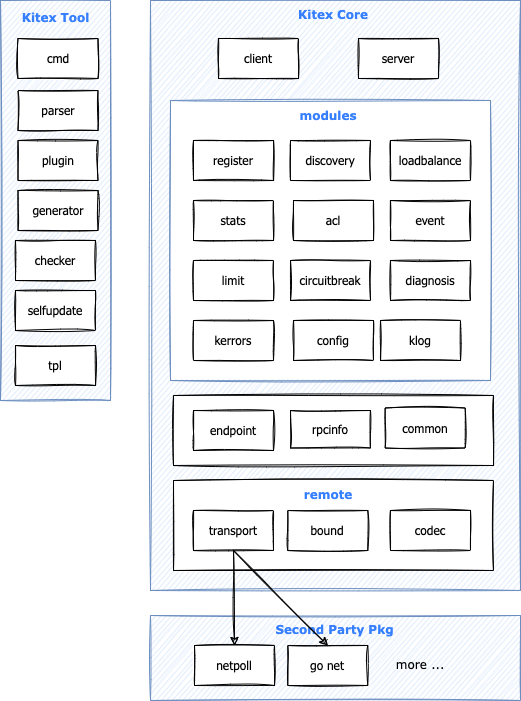
📕作者简介: 过去日记,致力于Java、GoLang,Rust等多种编程语言,热爱技术,喜欢游戏的博主。
📗本文收录于kitex系列,大家有兴趣的可以看一看
📘相关专栏Rust初阶教程、go语言基础系列、spring教程等,大家有兴趣的可以看一看
📙Java并发编程系列,设计模式系列、go web开发框架 系列正在发展中,喜欢Java,GoLang,Rust,的朋友们可以关注一下哦!
文章目录
- 概述
- 架构设计
- 框架特点
- 环境
- 代码生成工具
- IDL 编译器
- 安装IDL编译器
- kitex tool
- 基础教程
- 代码生成
- 拉取依赖
- 编写商品服务逻辑
- 运行商品服务
- 创建 client
- 暴露 HTTP 接口
- 测试接口
概述
Kitex字节跳动内部的 Golang 微服务 RPC 框架,具有高性能、强可扩展的特点,在字节内部已广泛使用。如果对微服务性能有要求,又希望定制扩展融入自己的治理体系,Kitex 会是一个不错的选择。
架构设计

框架特点
- 高性能
使用自研的高性能网络库 Netpoll,性能相较 go net 具有显著优势。 - 扩展性
提供了较多的扩展接口以及默认扩展实现,使用者也可以根据需要自行定制扩展,具体见下面的框架扩展。 - 多消息协议
RPC 消息协议默认支持 Thrift、Kitex Protobuf、gRPC。Thrift 支持 Buffered 和 Framed 二进制协议;Kitex Protobuf 是 Kitex 自定义的 Protobuf 消息协议,协议格式类似 Thrift;gRPC 是对 gRPC 消息协议的支持,可以与 gRPC 互通。除此之外,使用者也可以扩展自己的消息协议。 - 多传输协议
传输协议封装消息协议进行 RPC 互通,传输协议可以额外透传元信息,用于服务治理,Kitex 支持的传输协议有 TTHeader、HTTP2。TTHeader 可以和 Thrift、Kitex Protobuf 结合使用;HTTP2 目前主要是结合 gRPC 协议使用,后续也会支持 Thrift。 - 多种消息类型
支持 PingPong、Oneway、双向 Streaming。其中 Oneway 目前只对 Thrift 协议支持,双向 Streaming 只对 gRPC 支持,后续会考虑支持 Thrift 的双向 Streaming。 - 服务治理
支持服务注册/发现、负载均衡、熔断、限流、重试、监控、链路跟踪、日志、诊断等服务治理模块,大部分均已提供默认扩展,使用者可选择集成。 - 代码生成
Kitex 内置代码生成工具,可支持生成 Thrift、Protobuf 以及脚手架代码。
环境
代码生成工具
确保已经安装GoLang环境。
Kitex 中使用到的代码生成工具包括 IDL 编译器, protobuf 编译器,kitex tool。
IDL 编译器
IDL 编译器能够解析 IDL 并生成对应的序列化和反序列化代码,Kitex 支持 Thrift 和 protobuf 这两种 IDL,这两种 IDL 的解析分别依赖于 thriftgo 与 protoc。
安装IDL编译器
安装 thriftgo,执行以下命令即可:
go install github.com/cloudwego/thriftgo@latest
安装成功后,执行 thriftgo --version 可以看到具体版本号的输出:
thriftgo --version
thriftgo 0.3.6
protobuf 执行以下命令即可:
go install github.com/golang/protobuf/proto
安装成功后,执行 protoc --version 可以看到具体版本号的输出:
protoc --version
libprotoc 23.0
kitex tool
kitex 是 Kitex 框架提供的用于生成代码的一个命令行工具。目前,kitex 支持 thrift 和 protobuf 的 IDL,并支持生成一个服务端项目的骨架。kitex 的使用需要依赖于 IDL 编译器确保你已经完成 IDL 编译器的安装。
执行以下命令:
go install github.com/cloudwego/kitex/tool/cmd/kitex@latest
安装成功后,执行 kitex --version 可以看到具体版本号的输出:
kitex --version
v0.8.0
基础教程
首先我们我们创建一个名叫mykitex的文件,然后在命令行运行以下命令初始化模块。
go mod init mykitex
然后在根目录创建idl文件夹。
然后创建以下文件添加以下内容。
一般不同的服务都会使用不同的 IDL,所以我们这里创建 item.thrift 与 stock.thrift 分别定义商品服务与库存服务的接口,同时创建 base.thrift 定义公共数据结构。
base.proto
syntax = "proto3";
// 设置生成类的包路径
package base;// 输出路径;
option go_package = "example/shop/base";// 设置基础结构体
message BaseResp{string code=1;string msg=2;
}
item.proto
syntax = "proto3";
package item;
// 第一个分割参数,输出路径;第二个设置生成类的包路径option go_package = "example/shop/item";
// 引入公共文件
import "idl/base.proto";
// 所有字段默认必填,message Item {
int64 id=1;
string title=2;
string description=3;
int64 stock=4;
}message GetItemReq {int64 id=1;
}message GetItemResp {Item item=1;
base.BaseResp baseResp=255;
}service ItemService{rpc GetItem(GetItemReq) returns (GetItemResp);
}stock.proto
syntax = "proto3";
package item;
// 第一个分割参数,输出路径;第二个设置生成类的包路径
option go_package = "example/shop/stock";
// 引入公共文件
import "idl/base.proto";// 设置服务名称
message GetItemStockReq {int64 item_id = 1;
}message GetItemStockResp {int64 stock = 1;base.BaseResp base_resp = 255; // 在 protobuf 中,字段名应遵循小写字母和下划线的命名规范
}service StockService {rpc GetItemStock(GetItemStockReq) returns (GetItemStockResp);
}
代码生成
有了 IDL 以后我们便可以通过 kitex 工具生成项目代码了,我们在先回到项目的根目录即 example_shop。因为我们有两个 IDL 定义了服务,所以执行两次 kitex 命令:
kitex -module mykitex idl/item.protokitex -module mykitex idl/stock.proto
生成的代码分两部分,一部分是结构体的编解码序列化代码,由 IDL 编译器生成;另一部分由 kitex 工具在前者产物上叠加,生成用于创建和发起 RPC 调用的桩代码。它们默认都在 kitex_gen 目录下。
上面生成的代码并不能直接运行,需要自己完成 NewClient 和 NewServer 的构建。kitex 命令行工具提供了 -service 参数能直接生成带有脚手架的代码,接下来让我们为商品服务和库存服务分别生成脚手架。
首先为两个 RPC 服务分别单独创建目录。
mkdir -p rpc/item rpc/stock
再分别进入各自的目录中,执行如下命令生成代码:
// item 目录下执行
kitex -module mykitex -service example.shop.item -use mykitex/kitex_gen -I ../../ ../../idl/item.proto // stock 目录下执行
kitex -module mykitex -service example.shop.item -use mykitex/kitex_gen -I ../../ ../../idl/stock.proto
kitex 默认会将代码生成到执行命令的目录下,kitex 的命令中:
- -module 参数表明生成代码的 go mod 中的 module name,在本例中为 example_shop
- -service 参数表明我们要生成脚手架代码,后面紧跟的 example.shop.item 或 example.shop.stock 为该服务的名字。
- -use 参数表示让 kitex 不生成 kitex_gen 目录,而使用该选项给出的 import path。在本例中因为第一次已经生成 kitex_gen 目录了,后面都可以复用。
- 最后一个参数则为该服务的 IDL 文件
│ go.mod // go module 文件
│ go.sum
│
├─.idea
│ .gitignore
│ modules.xml
│ mykitex.iml
│ workspace.xml
│
├─idl // 示例 idl 存放的目录
│ base.proto
│ item.proto
│ stock.proto
│
├─kitex_gen
│ └─example
│ └─shop
│ ├─base // 根据 IDL 生成的编解码文件,由 IDL 编译器生成
│ │ base.pb.fast.go
│ │ base.pb.go
│ │
│ ├─item
│ │ │ item.pb.fast.go
│ │ │ item.pb.go
│ │ │
│ │ └─itemservice
│ │ client.go
│ │ invoker.go
│ │ itemservice.go
│ │ server.go
│ │
│ └─stock
│ │ stock.pb.fast.go
│ │ stock.pb.go
│ │
│ └─stockservice
│ client.go
│ invoker.go
│ server.go
│ stockservice.go
│
└─rpc├─item│ │ build.sh // 用来编译的脚本,一般情况下不需要更改│ │ handler.go // 服务端的业务逻辑都放在这里,这也是我们需要更改和编写的文件│ │ kitex_info.yaml│ │ main.go // 服务启动函数,一般在这里做一些资源初始化的工作,可以更改│ ││ └─script│ bootstrap.sh│└─stock│ build.sh│ handler.go│ kitex_info.yaml│ main.go│└─scriptbootstrap.sh拉取依赖
完成代码生成后,我们回到项目根目录。 使用 go mod tidy 命令拉取项目依赖
编写商品服务逻辑
我们需要编写的服务端逻辑都在 handler.go 这个文件中,目前我们有两个服务,对应了两个 handler.go,他们的结构都是类似的,我们先看看商品服务的服务端逻辑 rpc/item/handler.go
package mainimport ("context"item "example_shop/kitex_gen/example/shop/item"
)// ItemServiceImpl implements the last service interface defined in the IDL.
type ItemServiceImpl struct{}// GetItem implements the ItemServiceImpl interface.
func (s *ItemServiceImpl) GetItem(ctx context.Context, req *item.GetItemReq) (resp *item.GetItemResp, err error) {// TODO: Your code here...return
}
这里的 GetItem 函数就对应了我们之前在 item.thrift IDL 中定义的 GetItem 方法。
现在让我们修改一下服务端逻辑,本项目仅仅演示使用方法,重点不在于业务逻辑,故简单处理后返回。
package mainimport ("context"item "mykitex/kitex_gen/example/shop/item"
)// ItemServiceImpl implements the last service interface defined in the IDL.
type ItemServiceImpl struct{}// GetItem implements the ItemServiceImpl interface.
func (s *ItemServiceImpl) GetItem(ctx context.Context, req *item.GetItemReq) (resp *item.GetItemResp, err error) {resp = &item.GetItemResp{}resp.Item = &item.Item{}resp.Item.Id = req.GetId()resp.Item.Title = "Kitex"resp.Item.Description = "Kitex is an excellent framework!"return
}除了 handler.go 外,我们还需关心 main.go 文件,我可以看看 main.go 中做了什么事情:
rpc/item/main.go
package mainimport ("log"item "mykitex/kitex_gen/example/shop/item/itemservice"
)func main() {svr := item.NewServer(new(ItemServiceImpl))err := svr.Run()if err != nil {log.Println(err.Error())}
}
运行商品服务
2024/03/01 19:36:03.685752 server.go:83: [Info] KITEX: server listen at addr=[::]:8888在上面的日志输出中,addr=[::]:8888 代表我们的服务运行在本地的 8888 端口,此参数可以在创建 server 时传入 option 配置来修改,更多服务端配置见 Server Option。
创建 client
在生成的代码中,kitex_gen 目录下,Kitex 已经为我们封装了创建客户端的代码,我们只需要使用即可.
client/client.go
package mainimport ("context""github.com/cloudwego/kitex/client""log""mykitex/kitex_gen/example/shop/item""mykitex/kitex_gen/example/shop/item/itemservice""time"
)func main() {client, err := itemservice.NewClient("hello", client.WithHostPorts("0.0.0.0:8888"))if err != nil {log.Fatal(err)}for {req := &item.GetItemReq{Id: 1}resp, err := client.GetItem(context.Background(), req)if err != nil {log.Fatal(err)}log.Println(resp)time.Sleep(time.Second)}
}我们上述代码直接调用我们kitex工具自动生成的代码,
暴露 HTTP 接口
你可以使用 net/http 或其他框架来对外提供 HTTP 接口,此处使用 Hertz 做一个简单演示,有关 Hertz 用法参见 Hertz 文档
完整代码如下:
main.go
package mainimport ("context""mykitex/kitex_gen/example/shop/item""github.com/cloudwego/hertz/pkg/app""github.com/cloudwego/hertz/pkg/app/server""github.com/cloudwego/kitex/client""github.com/cloudwego/kitex/client/callopt""log""mykitex/kitex_gen/example/shop/item/itemservice""time"
)var (cli itemservice.Client
)func main() {c, err := itemservice.NewClient("example.shop.item", client.WithHostPorts("0.0.0.0:8888"))if err != nil {log.Fatal(err)}cli = chz := server.New(server.WithHostPorts("localhost:8889"))hz.GET("/api/item", Handler)if err := hz.Run(); err != nil {log.Fatal(err)}
}func Handler(ctx context.Context, c *app.RequestContext) {req := &item.GetItemReq{Id: 1}req.Id = 1024resp, err := cli.GetItem(context.Background(), req, callopt.WithRPCTimeout(3*time.Second))if err != nil {log.Fatal(err)}c.String(200, resp.String())
}接下来另启一个终端,执行 go run . 命令即可启动 API 服务,监听 8889 端口,请求 localhost:8889/api/item 即可发起 RPC 调用商品服务提供的 GetItem 接口,并获取到响应结果。
测试接口
打开游览器访问 localhost:8889/api/item,看到如下信息,代表请求成功。
item:{id:1024 title:“Kitex” description:“Kitex is an excellent framework!”}


)







Unity自带的角色控制器)




)



